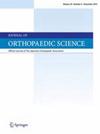Predictors of conversion surgery after conservative treatment for pyogenic spondylitis
IF 1.4
4区 医学
Q3 ORTHOPEDICS
引用次数: 0
Abstract
Background
Patient demographic and clinical characteristics may be factors associated with the success of conservative treatment for pyogenic spondylitis. The ability of imaging findings at initial diagnosis to predict patient outcomes remains unclear. The aim of this study was to investigate the risk factors associated with conversion surgery after conservative treatment for pyogenic spondylitis, with a special focus on the initial computed tomography (CT) findings.
Methods
This study enrolled 35 patients with pyogenic spondylitis who underwent CT and magnetic resonance imaging (MRI) at diagnosis and were followed-up for more than 6 months. Patients were diagnosed by MRI, and the degree of bone destruction was assessed on CT cross-sectional images. Vertebral body destruction was classified as grades 0 (almost normal), 1 (endplate irregularity), 2 (vertebral body destruction not involving the posterior wall), and 3 (destruction involving the posterior wall). Patients were divided into four groups based on grade of bone destruction and their clinical characteristics were compared.
Results
1, 11, 11, and 12 patients were classified as grades 0, 1, 2, and 3, respectively. Univariate analysis showed no significant differences in the demographic and clinical characteristics of the four groups. Eighteen (51.4 %) patients had been treated surgically, with the rate of surgical treatment being significantly higher in patients with grade 3 (83.3 %) than in those with grades 0 + 1 (25 %) and grade 2 (45.5 %) (P < 0.05). Multivariate analysis showed that epidural abscess on MRI (odds ratio [OR] 10.8, 95 % confidence interval [CI] 1.68–69.7), grade 3 bone destruction on CT (OR 3.97, 95 % CI 1.21–13.0), and C-reactive protein (CRP) improvement rate after 1 week of treatment (OR 0.95, 95 % CI 0.91–0.99) were risk factors for surgery.
Conclusions
Early surgical treatment should be considered for patients with pyogenic spondylitis who present with an epidural abscess on MRI and bone destruction extending to the posterior wall on CT at the time of diagnosis.
化脓性脊柱炎保守治疗后转化手术的预测因素。
背景:患者的人口统计学和临床特征可能是化脓性脊柱炎保守治疗成功的相关因素。初步诊断时的影像学检查结果预测患者预后的能力尚不清楚。本研究的目的是调查化脓性脊柱炎保守治疗后进行转化手术的相关风险因素,特别关注最初的计算机断层扫描(CT)结果。方法:本研究纳入了35例化脓性脊柱炎患者,他们在诊断时接受了CT和磁共振成像(MRI)检查,并进行了6个月以上的随访。患者通过MRI进行诊断,并通过CT横截面图像评估骨破坏程度。椎体破坏分为0级(几乎正常)、1级(终板不规则)、2级(不涉及后壁的椎体破坏)和3级(涉及后壁破坏)。根据骨破坏程度将患者分为四组,并比较其临床特征。结果:1、11、11和12名患者分别被分为0、1、2和3级。单变量分析显示,四组患者的人口统计学和临床特征没有显著差异。手术治疗18例(51.4%),其中3级患者的手术治疗率(83.3%)明显高于0+1级患者(25%)和2级患者(45.5%)(P结论:对于诊断时MRI显示硬膜外脓肿和CT显示骨破坏延伸至后壁的化脓性脊柱炎患者,应考虑早期手术治疗。
本文章由计算机程序翻译,如有差异,请以英文原文为准。
求助全文
约1分钟内获得全文
求助全文
来源期刊

Journal of Orthopaedic Science
医学-整形外科
CiteScore
3.00
自引率
0.00%
发文量
290
审稿时长
90 days
期刊介绍:
The Journal of Orthopaedic Science is the official peer-reviewed journal of the Japanese Orthopaedic Association. The journal publishes the latest researches and topical debates in all fields of clinical and experimental orthopaedics, including musculoskeletal medicine, sports medicine, locomotive syndrome, trauma, paediatrics, oncology and biomaterials, as well as basic researches.
 求助内容:
求助内容: 应助结果提醒方式:
应助结果提醒方式:


